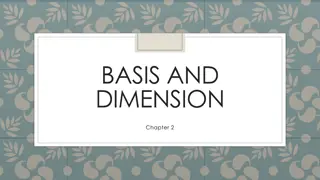Understanding Word Meaning through Vector Space Models
Explore how Vector-Space (Distributional) Lexical Semantics represent word meanings as points in a high-dimensional space. Learn about Semantic similarity, creating sample lexical vector spaces, and using word vectors to measure semantic relatedness. Discover how other contextual features and feature weights can enhance traditional methods like TF-IDF.
Download Presentation

Please find below an Image/Link to download the presentation.
The content on the website is provided AS IS for your information and personal use only. It may not be sold, licensed, or shared on other websites without obtaining consent from the author. Download presentation by click this link. If you encounter any issues during the download, it is possible that the publisher has removed the file from their server.
E N D
Presentation Transcript
Information Retrieval System Document corpus IR Query String System 1. Doc1 2. Doc2 3. Doc3 . . Ranked Documents 2
Vector-Space (Distributional) Lexical Semantics Represent word meanings as points (vectors) in a (high-dimensional) Euclidian space. Dimensions encode aspects of the context in which the word appears (e.g. how often it co- occurs with another specific word). You will know a word by the company that it keeps. (J.R. Firth, 1957) Semantic similarity defined as distance between points in this semantic space. 10
Sample Lexical Vector Space bottle cup water dog cat computer robot woman rock man 11
Simple Word Vectors For a given target word, w, create a bag-of- words document of all of the words that co- occur with the target word in a large corpus. Window of k words on either side. All words in the sentence, paragraph, or document. For each word, create a (tf-idf weighted) vector from the document for that word. Compute semantic relatedness of words as the cosine similarity of their vectors. 12
Other Contextual Features Use syntax to move beyond simple bag-of- words features. Produced typed (edge-labeled) dependency parses for each sentence in a large corpus. For each target word, produce features for it having specific dependency links to specific other words (e.g. subj=dog, obj=food, mod=red) 13
Other Feature Weights Replace TF-IDF with other feature weights. Pointwise mutual information (PMI) between target word, w, and the given feature, f: ? ?,? ? ? ?(?) ??? ?,? = ??? 14
Dimensionality Reduction Word-based features result in extremely high-dimensional spaces that can easily result in over-fitting. Reduce the dimensionality of the space by using various mathematical techniques to create a smaller set of k new dimensions that most account for the variance in the data. Singular Value Decomposition (SVD) used in Latent Semantic Analysis (LSA) Principle Component Analysis (PCA) 15
Neural Word2Vec (Mikolov et al., 2013) Learn an embedding of words that supports effective prediction of surrounding skip gram of words. 18
Skip-Gram Word2Vec Network Architecture Softmax classifier 19
Word2Vec Math Softmax classifier predicts surrounding words from a word embedding. Train to maximize the probability of skip- gram predictions. 20
Evaluation of Vector-Space Lexical Semantics Have humans rate the semantic similarity of a large set of word pairs. (dog, canine): 10; (dog, cat): 7; (dog, carrot): 3; (dog, knife): 1 Compute vector-space similarity of each pair. Compute correlation coefficient (Pearson or Spearman) between human and machine ratings. 21
TOEFL Synonymy Test LSA shown to be able to pass TOEFL synonymy test. 22
Vector-Space Word Sense Induction (WSI) Create a context-vector for each individual occurrence of the target word, w. Cluster these vectors into k groups. Assume each group represents a sense of the word and compute a vector for this sense by taking the mean of each cluster. 23
Sample Word Sense Induction Occurrence vectors for bat cave flew vampire hit ate baseball player wooden 24
Sample Word Sense Induction Occurrence vectors for bat cave flew + vampire hit ate baseball + player wooden 25
Word Sense and Vector Semantics Having one vector per word ignores the impact of homonymous senses. Similarity of ambiguous words violates the triangle inequality. club A B bat association C C A + B 26
Multi-Prototype Vector Space Models (Reisinger & Mooney, 2010) Do WSI and create a multiple sense-specific vectors for ambiguous words. Similarity of two words is the maximum similarity of sense vectors of each. club-1 club-2 bat-1 association bat-2 mouse-1 27
Vector-Space Word Meaning in Context Compute a semantic vector for an individual occurrence of a word based on its context. Combine a standard vector for a word with vectors representing the immediate context. 28
Example Using Dependency Context fired fired dobj dobj nsubj nsubj boss secretary hunter gun Compute vector for nsubj-boss by summing contextual vectors for all word occurrences that have boss as a subject. Compute vector for dobj-secretary by summing contextual vectors for all word occurrences that have secretary as a direct object. Compute in context vector for fire in boss fired secretary by adding nsubj-boss and dobj-secretary vectors to the general vector for fire 29
Compositional Vector Semantics Compute vector meanings of phrases and sentences by combining (composing) the vector meanings of its words. Simplest approach is to use vector addition or component-wise multiplication to combine word vectors. Evaluate on human judgements of sentence- level semantic similarity (semantic textual similarity, STS, SemEval competition). 30
Other Vector Semantics Computations Compute meanings of words by mathematically combining meanings of other words (Mikolov, et al., 2013) ???? = ????? ?????? + ???? Evaluate on solving word analogies King is to queen as uncle is to ______? 31
Sentence-Level Neural Language Models Skip-Thought Vectors (Kiros et al., NIPS 2015) Use LSTMs to encode whole sentences into lower- dimensional vectors. Vectors trained to predict previous and next sentences. S E N T. Jim jumped from the plane and opened his parachute. Jim landed on the ground. Encoder LSTM Decoder LSTM V E C T O R 32
Conclusions A word s meaning can be represented as a vector that encodes distributional information about the contexts in which the word tends to occur. Lexical semantic similarity can be judged by comparing vectors (e.g. cosine similarity). Vector-based word senses can be automatically induced by clustering contexts. Contextualized vectors for word meaning can be constructed by combining lexical and contextual vectors. 33























